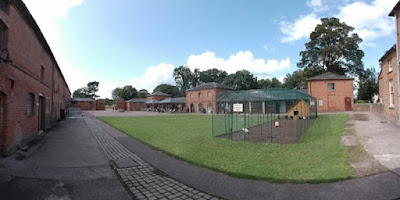I have loads of multimedia from five different great houses I visited during my trip to England to share with you all, and lacking any better ordering I'm going to go in what was chronological order for me, which was also generally northwards. So first up is Shugborough Estate. This is a National Trust property although more recently so, as it was given to the National Trust in lieu of death duties in 1960 and then leased to the Staffordshire County Council, and has only been back under National Trust operation since 2016.
I was particularly interested in this one because of the estate portion of its name. Often when you visit these great houses, you get to see the most noteworthy portions of the house and then the landscape gardens, and they are often now including the servants' quarters (I've read visitors are asking for these more and they're having to be converted out of offices...I expect it's the Downton Abbey effect). But Shugborough included more of the working estate, or so I had read, and the more I can learn about the more behind the scenes aspects of these great houses, the better, as estate management plays a role at points in my series.
What I found there wasn't quite what I was expecting, but it was still useful. The "estate" portion is really more of a farm, which would have been the home farm for the estate. It's also, strangely enough, designed by architect Samuel Wyatt, who was one of the leading architects of his day (but not my favorite...we'll get to him in future posts). We tend to think of architects as specifically designers of buildings in the modern definition of the term, but back then it was still a developing role, and so you see architects better known for buildings also designing landscapes (and vice versa), also doing interior designs and sometimes even furniture, and in this case designing the layout and buildings of a farm, as you can see in the photos below:
The exhibits within the farm explained the various roles that people would have held on the farm in the Georgian era, but probably the highlight was the bailiff's house. The bailiff would have been the person responsible for managing the farm (whereas a steward like George Wickham's father would have overarching responsibility for the entire estate including the home farm and tenanted farms), and so this house is a unique chance to see how someone at that level of society would have lived, which is pretty good (although not nearly so good as in the great house), as you can see in the 360 photo and video below (all of the videos in this post are 360s, so you can either watch them as they are or pan about to see different things as you watch):
Beyond the farm, there is a dairy, which would have been part ornamental dairy (for those great ladies who like to play at farming, a la Marie Antoinette) and part functioning dairy. Only the ornamental part was open, though.
The house itself isn't particularly remarkable compared to some we'll see in future posts, but still worth taking a look at. And it was inhabited by some interesting people: Thomas Anson, who never married and therefore the estate passed to his much more famous brother, George Anson, who as a commodore (a temporary naval rank for a captain commanding a squadron) captured a Spanish treasure ship and circumnavigated the world. The estate passed to his son, who became the first Earl of Lichfield, and in the 20th century passed to Patrick Lichfield, who was a famous society photographer (his apartment in the house is a separate tour and photos aren't allowed as his photography remains under copyright).
What impressed me most, though, were the servants' quarters, which were extensive (I believe the county council had maintained them as a museum before) and really showed a full suite of rooms (larder, kitchen, scullery, laundry, etc.) surrounding this rather nondescript courtyard:
That's all I've got for now, but if you enjoyed all of that multimedia, I've got plenty more for future posts! And next month's house is one that will look familiar to you 1996 Pride and Prejudice miniseries fans, so watch this space.

















.jpg)

No comments:
Post a Comment